Comets are thought to represent leftover building blocks of the solar system; Jennifer Newton finds more questions than answers
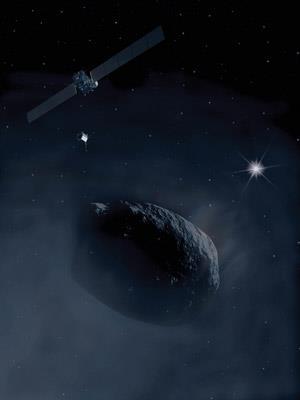
‘In between heaven and hell,’ is how Uwe Meierhenrich describes the time after the European Space Agency lander Philae had touched down on Comet 67P/Churyumov-Gerasimenko on 12 November 2014. He is part of the Cosac GC–MS instrument team, which was being given a chance to take a sample. Other instrument teams were not going to be so lucky.
Philae’s rendezvous with 67P made headlines last year, as the world awaited news from mission control. Meierhenrich, an analytical chemist at the University of Nice in France, can recount those few days down to the hour. The tension that the watching world felt was nothing in comparison to the scientists and engineers involved in the mission, many of whom had taken a gamble with their careers and started working towards this moment almost a decade before. ‘In 2002, I was a young postdoc in the Max Planck Institute of Solar System Research in Germany where the Cosac instrument was developed, designed and created,’ says Meierhenrich. ‘As a postdoc it was a high risk for me to participate in a space mission where the results wouldn’t come back until 2014.’
Meierhenrich highlights two late scientists for their contributions to comet theory; Fred Whipple and Mayo Greenberg. Whipple defined comet nuclei as solid objects composed of mainly water ice as part of his ‘dirty snowball’ model in the 1950s, when he was a professor of astronomy at Harvard University in the US. Greenberg, who directed the Laboratory for Astrophysics at the University of Leiden in the Netherlands, acknowledged Whipple’s theory with his notion that comets would mimic the universe at large, minus those elements that did not freeze or form compounds. And building on Whipple’s concept, Greenberg theorised more recently that comets are composed of small, interstellar dust grains smaller than a micrometre, with their own individual icy mantles, that agglomerate into comets.
It was when he was working with Greenberg that Meierhenrich found 16 different amino acids on simulating cometary conditions in the lab at the beginning of the 21st century.1 This momentous experiment built anticipation for the Rosetta mission and was analysed with the same GC–MS set-up that would go on to ride aboard Philae.
On the one hand…
Landing on a comet was an astounding accomplishment, even if it didn’t go quite to plan. Meierhenrich agrees but at the same time contends that in the grand scheme of landing on Mars to look for organics, landing on a comet could be seen as a rather trivial task. So what makes the Philae mission so beautiful? ‘The answer is we do not exclusively look for organic molecules. If we find organic molecules then we would like to know about chirality,’ says Meierhenrich.
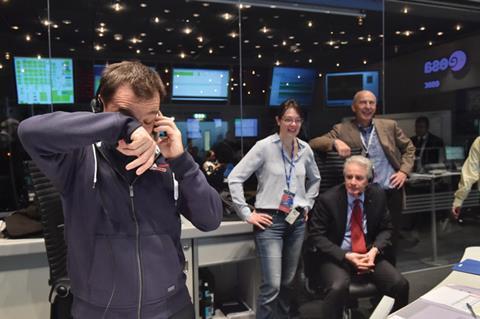
Chirality distinguishes between left- and right-handed molecules. Living organisms, as we know them, contain amino acids solely in the left-hand form. ‘We do not only want to detect organic molecules,’ explains Meierhenrich. ‘We want to characterise them as left or right-handed. Do we find more of left or right?’
A crucial question for physicists, biologists and chemists is whether the molecules in space are racemic or not. ‘Physicists, they love this question, whether you have symmetric or asymmetric properties,’ says Meierhenrich. ‘If they’re asymmetric they want to know why.’ It’s the same with matter and anti-matter, and positive and negative charge. ‘They assume the entire universe is not charged because you have the same amount of negative charge as positive charge. So the same is true for this chirality phenomenon. Physicists would love to have the universe having the same amount of left- and right-handed molecules so that everything is symmetric, which would be easy to explain. But in life we have this property where we only have left-handed amino acids. So this is a big question for physicists, but also for chemists and biologists.’
The Rosetta mission is the first to be equipped with an instrument (Cosac; cometary sampling and composition) that not only detects organic molecules on the cometary surface but is also able to distinguish between their chirality. ‘This is what makes the Cosac instrument unique,’ says Meierhenrich. ‘People say this is the main experiment on board Philae.’
Philae had been set to automatically take a sample for Cosac 20 minutes after it had landed on 67P. But 20 minutes after the initial touchdown it was back up in the air, having failed to grip onto the cometary surface. After about two hours bouncing around the comet’s surface, Philae managed to settle and instructions were sent to drill for a sample. Then things went quiet and people started to panic. Joy turned to despair. They announced there was no data.
But there was still hope. ‘Maybe during drilling, Philae and her antenna moved a little, so perhaps there will be another time window when data comes back?’ says Meierhenrich.
That was what happened, and 420 GC-MS spectra came in. Half an hour later, Philae’s battery was empty and it has only ‘woken up’ recently. Meanwhile, Cosac’s team are busy analysing and debating that data.
Fluffy dust
Rosetta itself has treated the scientific community to some fascinating findings. The on-board Cosima (cometary secondary ion mass analyser) instrument collected and analysed dust grains 10–20 km from 67P.2 Many of the grains shattered on contact with the collection plate, indicating that they were agglomerates. They don’t contain any ice – if they had, they wouldn’t have shattered – but do have lots of sodium. The European Space Agency (ESA) team concluded that this means they are probably parent materials for interplanetary dust particles. Although this seems to contradict Whipple and Greenberg’s cometary descriptions, the researchers still expect to find ice deeper within the comet.

Cosmochemist Natalie Starkey of the UK’s Open University says the dust from 67P looks identical to space dust she analyses, which is usually 10–100µm in size and collected from the Earth’s stratosphere by Nasa’s high flying aircraft. Starkey says she can never be sure that the dust she works with is necessarily comet dust, but there’s lots of information that hints that it is. ‘We also get terrestrial dust – dust from volcanoes and small rounded blobs of aluminium that’s rocket fuel – on the collectors, but these are easy to spot.’
Cometary dust streams will encounter the Earth’s atmosphere at a different velocity, eccentricity and inclination to dust from asteroids. Starkey can tell when the dust is from a primitive source – like a comet or asteroid made of some of the oldest material in the solar system – by analysing samples with Raman spectroscopy. ‘The organic material contained in them is more pristine than anything we measure in the meteorites, which are samples from asteroids. The dust samples also contain huge amounts of pre-solar grains that indicate the samples are unaltered, unlike meteorites from asteroids, which have undergone a lot of thermal and aqueous alteration because of their proximity to the Sun,’ she explains.
Starkey focuses on analysing the isotopes of oxygen, carbon, nitrogen and hydrogen as these can reveal information about the rocky and organic components in the comet dust.3 ‘I’m trying to build up a picture of the early solar system to understand the composition of the early-formed dust and gas reservoirs and how they are related. This allows me to speculate as to the importance of comets in the history of the Earth because it is thought that comets colliding with Earth in the past may have delivered water and organic material – the seeds for life.’
The problem with orphans
‘We get some samples for free in the form of meteorites and collect some from the upper atmosphere, but the problem with samples collected from the upper atmosphere is all of these samples are orphans: we know they come from space, but we don’t know which object they come from and we know there’s a huge diversity of objects out there,’ says Scott Sandford, one of the scientists who runs the astrochemistry lab at Nasa Ames. There have only been a modest number of space missions that return a sample to Earth but Sandford has worked on pretty much every one.
‘These are complicated and difficult missions because getting there is hard, but getting there and back is more than twice as hard,’ explains Sandford. He was involved in the Stardust mission that launched in 1999 and flew by comet Wild 2 in 2004 at a velocity of just over 6km/s, which is about Mach 20. An aerogel collecter on the side of the spacecraft gathered samples from Wild 2’s coma, the ‘atmosphere’ surrounding a comet’s nucleus. Although designed to collect the material as gently as possible, Sandford says ‘It was like shooting ball-bearings at Styrofoam rather than at a wall. I’ve never run into anything at Mach 20 but I’m sure it hurts!’ The dust still transformed on collision with the aerogel.
I’ve never run into anything at Mach 20 but I’m sure it hurts
Before the mission, the Nasa Ames team watched how known material changed on being shot into the aerogel from a gas gun. They expected the aerogel to work to some extent, but not perfectly. Tests revealed that meteoric minerals, like olivine, might melt on impact, but they’d still survive. Organic compounds, however, are more fragile and don’t survive as well. One of the more dramatic tests the Nasa team did was to fire cocoa powder into the aerogel. It was heavily modified. ‘We probably hold the record for the world’s fastest hot chocolate,’ jokes Sandford.
The Stardust mission returned complex samples containing clumps of silicate minerals and other minerals, along with organics all mixed together, but there’s no guarantee that it is the original material. At the same time, organics protected by surrounding mineral grains did survive and some of them were found to be quite complex.
Primitive washing machine
Prior to the Stardust mission, comets were assumed to be assembled in the outer solar system from junk in the cold interstellar medium. Stardust samples did contain those kinds of materials – organics with weird isotopic anomalies suggesting they never got that hot. But they also saw mineral grains that were formed at the very highest temperatures at which they can form. ‘So they must have formed in the inner solar system then walked their way back out,’ explains Sanford. Before Stardust, a common view was that the matter surrounding a star forms into a disk shape then moves towards the central star, with some left behind to make a planet, but Sanford says the early solar system appears to be more like a washing machine, with things going both in and out. Comets contain matter from across the solar system and end up being repositories for everything – a wonderful treasure chest to rummage through but also a lot more complex to understand. Grains sit next to others that clearly did not form in the same place at the same time so the relationship between them is tangled.
Atrophysicist Tom McCord, who is the director of the Bear Fight Institute in Washington state, US, and also part of Rosetta’s Virtis (visible and infrared thermal imaging spectrometer) team, urges caution when labelling comets as samples from the early formation of the solar system. How the comet is put together and whether it shows evidence of processing after accretion need to be established before drawing conclusions.
McCord, who has been involved in space research since the Apollo missions, is astounded by how much more complex our cosmic understanding is now. ‘Non-scientists have expanded what they count within their near-personal environment to include our solar system, when 50 years ago it would be their own country, or maybe their continent. It’s a profound change in vision and it’s because of the new knowledge we’ve gained.’
Predicting the unpredictable
But back to those organics. According to McCord, one of the most profound, if not the most profound, questions that future missions across the solar system can answer is: Can life originate and evolve independently of the Earth?

Sandford wants to know if comets contain, and could have therefore dumped on early Earth, chemicals called amphiphiles that can aggregate into membrane structures in water. ‘We still don’t know how life got started on Earth, but if you look at life as a kind of organised Lego castle, then I think most people would agree it’s probably easier to make a Lego castle if the building blocks are falling from the sky than if they’re not,’ he quips.
In the lab, Sandford’s team creates ices as cold as 6K and bombards them with ionising radiation to simulate conditions in space. He describes it as very weird chemistry – normal thermodynamic, equilibrium or redox relationships don’t apply. ‘These reactions are very stochastic, since all the molecules, ions and radicals are trapped in an ice – they’re not free to move around. So if they can react with a neighbour they do; if they can’t, they just sit there stored as an unhappy radical until they can.’ Some chemistry happens at low temperature but a lot happens once the ice warms up and starts to sublime. But almost all of the reactions are ‘mergers of convenience’, and rather than just a modest number of products you get hundreds of thousands. Over the past few decades, Sandford and colleagues have made all sorts of amino acids, amphiphiles, nucleobases and quinones in this way. But he says at the same time the bulk of the residues they make are still not understood.
Astrobiology has given scientists a means of cherry-picking the compound, for example glycine, they check for. But it’s hard to know what else to ask. ‘I’m sure many of the other compounds we make can’t be bought from Sigma–Aldrich as a standard to test, firstly because no one has any use for them and secondly they’re unlikely to be that stable,’ explains Sandford. He suspects, however, that this complexity helped get life started.
Knowing what questions to ask while keeping an open mind is the best way to progress, comments Meierhenrich. He says the entire Rosetta mission can be interpreted as ‘We ask a question to the comet and the comet replies.’
References
1 G M Muñoz Caro et al, Nature, 2002, 416, 403 (DOI: 10.1038/416403a)
2 R Schulz et al, Nature, 2015, 518, 216 (DOI: 10.1038/nature14159)
3 N A Starkey and I A Franchi, Geochim. Cosmochim. Acta, 2013, 105, 73 (DOI: 10.1016/j.gca.2012.11.040) and N A Starkey, I A Franchi and M R Lee, Geochim. Cosmochim. Acta, 2014, 142, 115 (DOI: 10.1016/j.gca.2014.07.011)

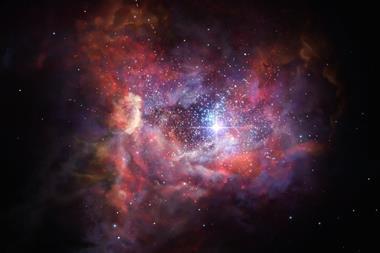
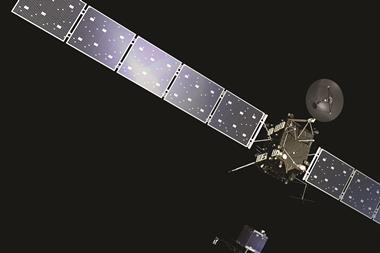

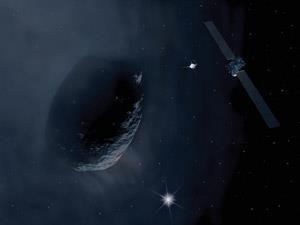







No comments yet